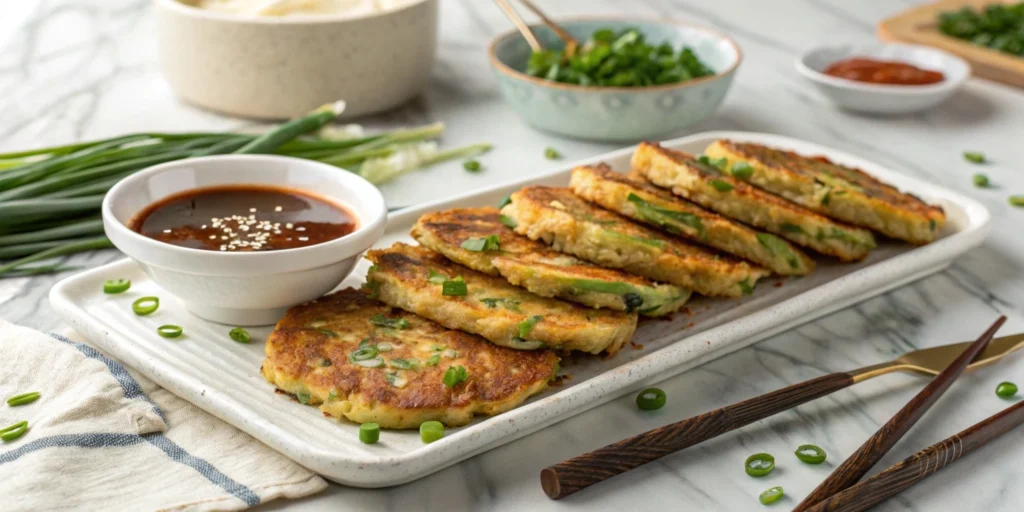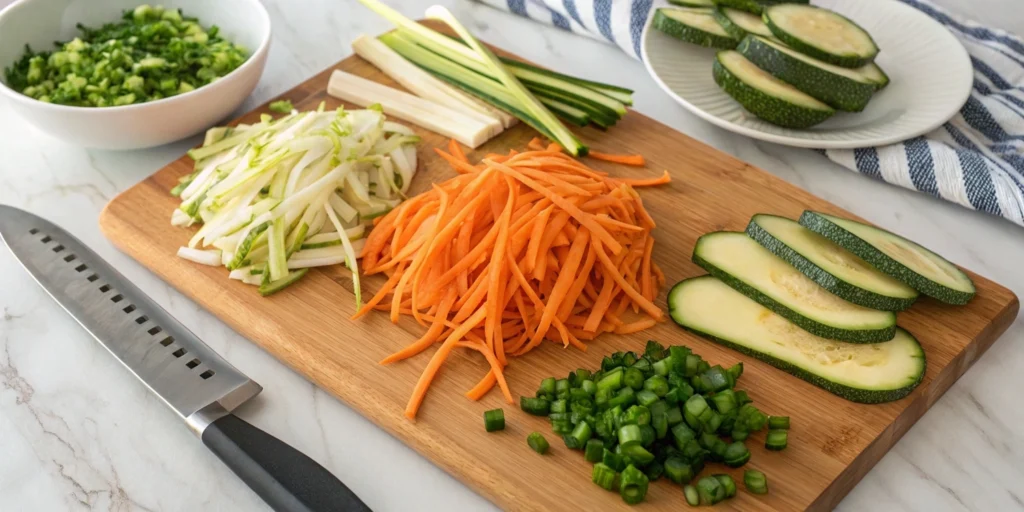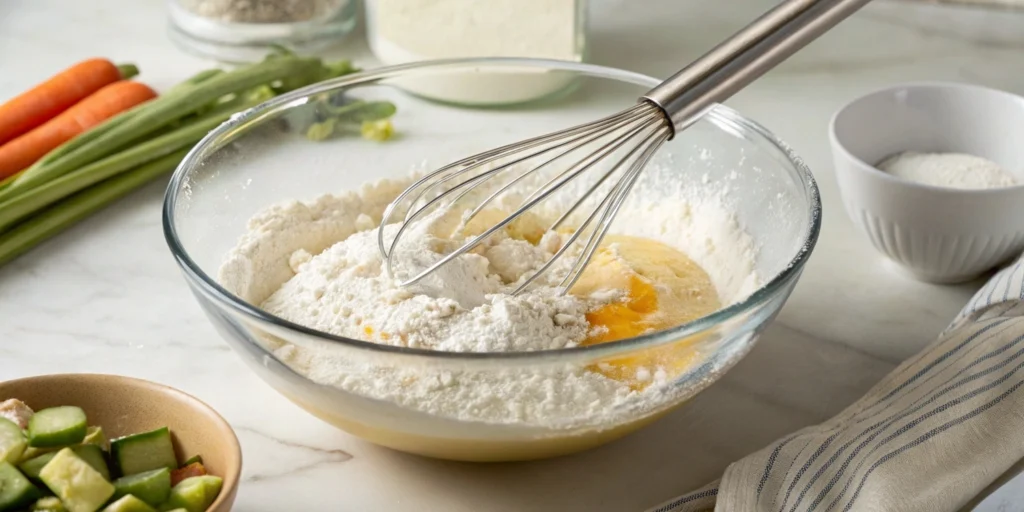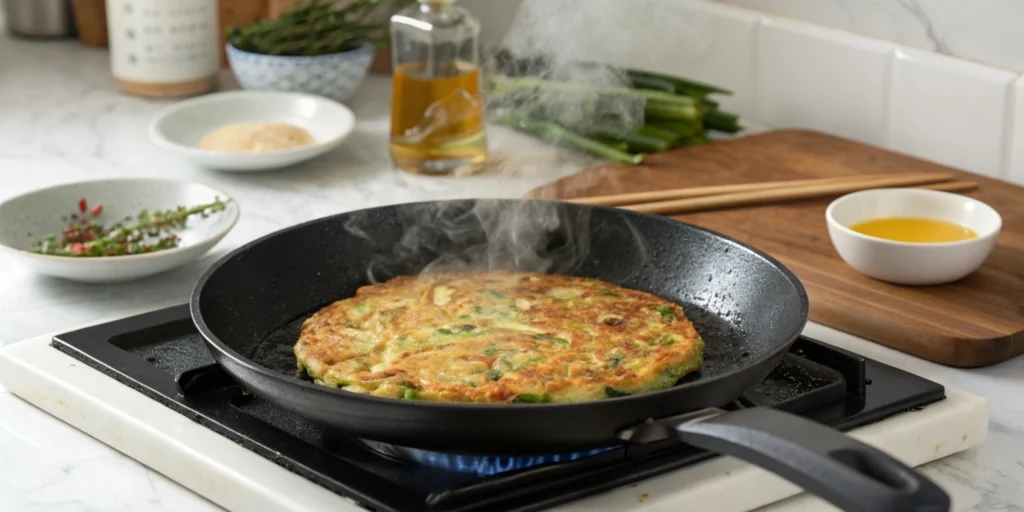
Table of Contents
Korean veggie pancakes, known as 야채전 (Yachaejeon), are a timeless dish that brings comfort and joy to countless homes. My first encounter with these crispy delights was at my grandmother’s house, where she prepared them on an old wood-fired stove. The sizzling sound and the savory aroma filling the air were unforgettable. Today, I’m sharing this classic recipe with you so you can enjoy the same comforting flavors, prepared quickly in your modern kitchen.
What Are Korean Veggie Pancakes?
Korean veggie pancakes are a savory treat made by combining fresh vegetables with a light batter and frying them to golden perfection. These pancakes are incredibly versatile—you can enjoy them as a snack, appetizer, or side dish. They’re quick to prepare and highly customizable, making them ideal for busy weeknights or impromptu gatherings.
Why You’ll Love This Recipe
- Quick and Easy: Ready in just 15 minutes, this recipe fits perfectly into your busy schedule.
- Healthy Ingredients: Packed with vegetables like carrots, zucchini, and green onions, it’s both delicious and nutritious.
- Customizable: Use your favorite vegetables or whatever you have on hand.
- Crispy and Delicious: Achieve a satisfying crunch with each bite, paired with a rich, savory flavor.
Ingredients You’ll Need

For the Pancakes:
- 1 cup all-purpose flour – The base of the batter, creating the perfect texture.
- 2 tablespoons cornstarch – Ensures extra crispiness in every bite.
- 3/4 cup cold water – Cold water helps keep the batter light and crispy.
- 1/2 cup julienned carrots – Adds sweetness and vibrant color.
- 1/2 cup julienned zucchini – Brings a soft texture and mild flavor.
- 1/4 cup chopped green onions – Provides a subtle kick and aromatic depth.
- 1/4 teaspoon salt – Enhances the natural flavors of the ingredients.
- Vegetable oil for frying – Use a neutral oil for best results.
For the Dipping Sauce:
- 2 tablespoons soy sauce – The base of the sauce, rich in umami.
- 1 tablespoon vinegar – Adds a tangy contrast to the savory pancakes.
- 1 teaspoon sesame oil – Imparts a nutty aroma.
- 1/4 teaspoon red pepper flakes – Optional, for a bit of heat.
Step-by-Step Instructions
1. Prepare Your Vegetables
Start by washing and julienning the carrots and zucchini into thin, uniform strips. Chop the green onions into small pieces. For best results, pat the vegetables dry with a paper towel to remove excess moisture. This step ensures the pancakes fry up crispy.
2. Mix the Batter
In a large mixing bowl, combine the all-purpose flour, cornstarch, and salt. Gradually add the cold water while whisking until you achieve a smooth, lump-free batter. Cold water is essential for creating a light and crispy texture.

3. Combine and Cook
Fold the prepared vegetables into the batter, ensuring they’re evenly coated. Heat a non-stick pan over medium-high heat and add a tablespoon of vegetable oil. Once the oil is hot, pour a ladleful of the batter into the pan, spreading it out thinly with the back of a spoon. Cook for 2-3 minutes on each side, or until the pancake is golden brown and crispy. Continue cooking the remaining batter, ensuring to add a little more oil between batches to maintain crispiness.

4. Prepare the Dipping Sauce
While the pancakes are cooking, whisk together the soy sauce, vinegar, sesame oil, and red pepper flakes in a small bowl. Adjust the seasoning to taste.
Tips for Perfect Korean Veggie Pancakes
- Use Cold Water: This trick helps the batter stay light and airy, resulting in crispier pancakes.
- Don’t Overload the Pan: Cook one pancake at a time to ensure even frying and a perfect golden crust.
- Serve Immediately: These pancakes are best enjoyed fresh off the pan while they’re still hot and crispy.
- Customize Your Vegetables: Feel free to swap out ingredients or add others, like bell peppers, mushrooms, or spinach, to suit your taste.
Nutritional Benefits
Korean veggie pancakes are not only tasty but also packed with nutritional benefits:
- Low in Calories: Each pancake is relatively low in calories, making it a guilt-free indulgence.
- Rich in Fiber: The carrots and zucchini provide dietary fiber, supporting healthy digestion.
- Vitamins and Minerals: Carrots offer vitamin A, while zucchini provides vitamin C and potassium, boosting your overall health.
Serving Suggestions
These pancakes pair beautifully with a variety of dishes. Try serving them with:
- Kimchi: The tangy, spicy flavors complement the savory pancakes.
- Bibimbap: Add them as a side dish to a hearty bowl of mixed rice and vegetables.
- Light Soup: A bowl of miso soup or clear vegetable broth balances the meal.
For an authentic Korean experience, serve Yachaejeon with the dipping sauce on the side and chopsticks at the ready.
FAQs About Korean Veggie Pancakes
What makes Korean veggie pancakes crispy?
The secret lies in using cold water for the batter and ensuring the pan and oil are hot before cooking. Adding cornstarch to the batter also enhances the crispiness.
Can I make these pancakes gluten-free?
Absolutely! Substitute the all-purpose flour with a gluten-free blend, and you’ll achieve a similar result.
Can I use other vegetables?
Yes! Feel free to experiment with mushrooms, bell peppers, spinach, or any vegetables you love.
How do I store leftovers?
Store any leftover pancakes in a sealed container and keep them in the refrigerator for up to three days. To reheat, use a pan to restore the crispiness instead of a microwave.
Can I freeze Korean veggie pancakes?
Yes, you can freeze them! Stack the pancakes with parchment paper in between, place them in a freezer-safe bag, and store for up to two months. Reheat them in a pan or oven directly from frozen.
Conclusion: A Delight for Your Taste Buds
With their crispy edges, tender vegetables, and rich dipping sauce, Korean veggie pancakes are a dish that transcends simplicity. They’re quick to make, packed with flavor, and bring a slice of Korean culinary tradition right to your kitchen. Whether you’re cooking for yourself, your family, or a group of friends, these pancakes are sure to impress.
So gather your ingredients, heat up your pan, and savor the joy of homemade Yachaejeon. You’ll wonder why you didn’t make them sooner!
